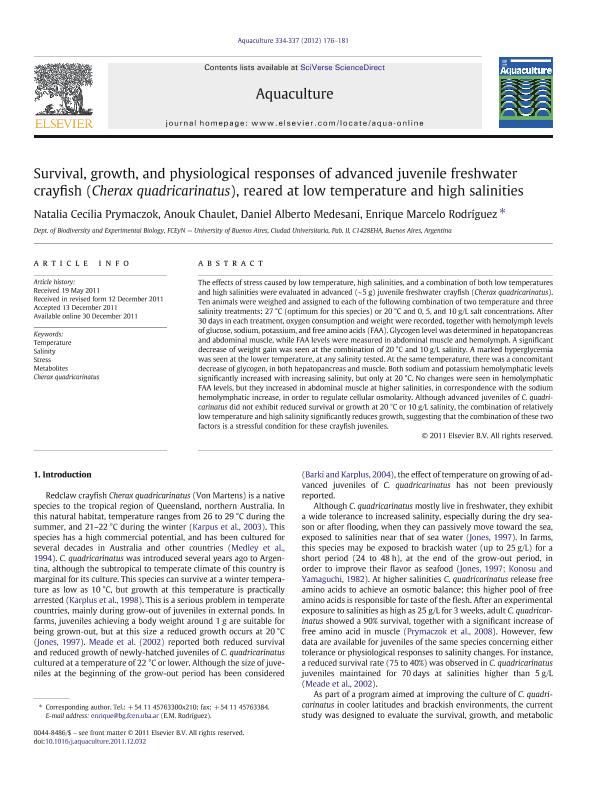Mostrar el registro sencillo del ítem
dc.contributor.author
Prymaczok, Natalia Cecilia

dc.contributor.author
Chaulet, Anouk

dc.contributor.author
Medesani, Daniel Alberto

dc.contributor.author
Rodriguez, Enrique Marcelo

dc.date.available
2023-05-24T10:22:47Z
dc.date.issued
2012-03
dc.identifier.citation
Prymaczok, Natalia Cecilia; Chaulet, Anouk; Medesani, Daniel Alberto; Rodriguez, Enrique Marcelo; Survival, growth, and physiological responses of advanced juvenile freshwater crayfish (Cherax quadricarinatus), reared at low temperature and high salinities; Elsevier Science; Aquaculture; 334-337; 3-2012; 176-181
dc.identifier.issn
0044-8486
dc.identifier.uri
http://hdl.handle.net/11336/198514
dc.description.abstract
The effects of stress caused by low temperature, high salinities, and a combination of both low temperatures and high salinities were evaluated in advanced (~. 5. g) juvenile freshwater crayfish (Cherax quadricarinatus). Ten animals were weighed and assigned to each of the following combination of two temperature and three salinity treatments: 27 °C (optimum for this species) or 20 °C and 0, 5, and 10. g/L salt concentrations. After 30. days in each treatment, oxygen consumption and weight were recorded, together with hemolymph levels of glucose, sodium, potassium, and free amino acids (FAA). Glycogen level was determined in hepatopancreas and abdominal muscle, while FAA levels were measured in abdominal muscle and hemolymph. A significant decrease of weight gain was seen at the combination of 20 °C and 10. g/L salinity. A marked hyperglycemia was seen at the lower temperature, at any salinity tested. At the same temperature, there was a concomitant decrease of glycogen, in both hepatopancreas and muscle. Both sodium and potassium hemolymphatic levels significantly increased with increasing salinity, but only at 20 °C. No changes were seen in hemolymphatic FAA levels, but they increased in abdominal muscle at higher salinities, in correspondence with the sodium hemolymphatic increase, in order to regulate cellular osmolarity. Although advanced juveniles of C. quadricarinatus did not exhibit reduced survival or growth at 20 °C or 10. g/L salinity, the combination of relatively low temperature and high salinity significantly reduces growth, suggesting that the combination of these two factors is a stressful condition for these crayfish juveniles.
dc.format
application/pdf
dc.language.iso
eng
dc.publisher
Elsevier Science

dc.rights
info:eu-repo/semantics/openAccess
dc.rights.uri
https://creativecommons.org/licenses/by-nc-sa/2.5/ar/
dc.subject
CHERAX QUADRICARINATUS
dc.subject
METABOLITES
dc.subject
SALINITY
dc.subject
STRESS
dc.subject
TEMPERATURE
dc.subject.classification
Otros Tópicos Biológicos

dc.subject.classification
Ciencias Biológicas

dc.subject.classification
CIENCIAS NATURALES Y EXACTAS

dc.title
Survival, growth, and physiological responses of advanced juvenile freshwater crayfish (Cherax quadricarinatus), reared at low temperature and high salinities
dc.type
info:eu-repo/semantics/article
dc.type
info:ar-repo/semantics/artículo
dc.type
info:eu-repo/semantics/publishedVersion
dc.date.updated
2023-04-19T14:56:12Z
dc.journal.volume
334-337
dc.journal.pagination
176-181
dc.journal.pais
Países Bajos

dc.journal.ciudad
Amsterdam
dc.description.fil
Fil: Prymaczok, Natalia Cecilia. Universidad de Buenos Aires. Facultad de Ciencias Exactas y Naturales. Departamento de Biodiversidad y Biología Experimental; Argentina. Consejo Nacional de Investigaciones Científicas y Técnicas. Oficina de Coordinación Administrativa Ciudad Universitaria; Argentina
dc.description.fil
Fil: Chaulet, Anouk. Universidad de Buenos Aires. Facultad de Ciencias Exactas y Naturales. Departamento de Biodiversidad y Biología Experimental; Argentina. Consejo Nacional de Investigaciones Científicas y Técnicas. Oficina de Coordinación Administrativa Ciudad Universitaria; Argentina
dc.description.fil
Fil: Medesani, Daniel Alberto. Universidad de Buenos Aires. Facultad de Ciencias Exactas y Naturales. Departamento de Biodiversidad y Biología Experimental; Argentina. Consejo Nacional de Investigaciones Científicas y Técnicas. Oficina de Coordinación Administrativa Ciudad Universitaria; Argentina
dc.description.fil
Fil: Rodriguez, Enrique Marcelo. Universidad de Buenos Aires. Facultad de Ciencias Exactas y Naturales. Departamento de Biodiversidad y Biología Experimental; Argentina. Consejo Nacional de Investigaciones Científicas y Técnicas. Oficina de Coordinación Administrativa Ciudad Universitaria; Argentina
dc.journal.title
Aquaculture

dc.relation.alternativeid
info:eu-repo/semantics/altIdentifier/url/https://www.sciencedirect.com/science/article/pii/S0044848611010143
dc.relation.alternativeid
info:eu-repo/semantics/altIdentifier/doi/http://dx.doi.org/10.1016/j.aquaculture.2011.12.032
Archivos asociados
